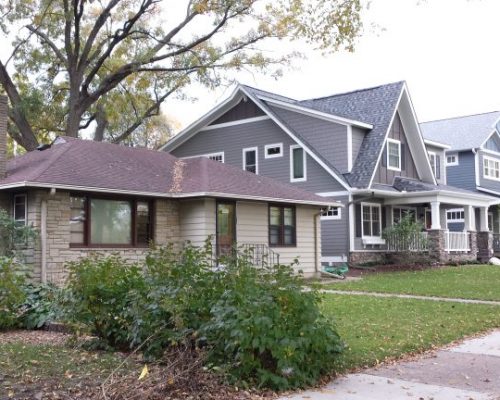Article
single-family
Housing- a waste of space
As southwest Minneapolis takes a strong stand against density by arguing for the preservation of the “character of their neighborhood”, let’s take a look at the inefficiencies of living in a single-family house.
Take me, for example. I live in south Minneapolis in a single-family house. It’s 1,800 square feet. The occupants of the house are me and my partner—an adult female and an adult male—and a cat. I’ve owned the house since 2003. In the years since I’ve owned the house, how much time have I actually spent in my house?
Think about it. In order to afford a house, you need a job—a job that you most likely have ttravel to. So from, say, 7:00 am to 6:00 pm, you’re either working on getting to and from work. The house sits empty except for the cat who sleeps all day. You get home, finally. You prepare a meal and afterward go into the living room and read a book and watch TV until bed, say 10:00 pm. So on any given day you might be spending four hours actually awake and moving around in your house.
And, of all the space in the house, you actually spend time in three rooms primarily: kitchen, living room, and bedroom. So 33 percent of the space is used consistently. Are we maximizing our use of space based on our mortgage payment? Probably not. Between the three of us, we could possibly get by with 600 square feet.
Data demonstrates that the single-family house is an outdated concept. When I look at my neighborhood, I see how the lives of my neighbors are changing. It fits with the trend that has been reported on before, Chart of the Day: Twin Cities Household Size and Age Forecasts that there are more people living alone or with only one other person.
I have a few neighbors whose children have already moved out or soon will be. I see them reducing the number of vehicles they own because they no longer need a larger vehicle to haul kids around. But what about their living arrangements? If you look at southwest Minneapolis, there are many adults who are living alone in houses that are probably too large for what they need.
Minneapolis is following a national trend that was reported in 2016, that single-family housing primarily built for a nuclear family no longer fits into the future demographics of the city, The Decline of Families Could Mean a Change in Housing Demand. I hear the arguments of those who don’t want to leave their neighborhood or a house that they have lived in for many years. I get that. I hate transitions, but I also know that the space I take up in my single-family house is preventing others from finding adequate housing. It also keeps the status quo, continues inequities in housing due to single-family zoning restrictions, and as a contributing factor in social isolation: Single-Family Housing Upholds the Patriarchy and Hurts Moms.
What’s the solution? I think it’s inevitable that southwest Minneapolis will change with the changing demographics and housing pressures, but I don’t think the answer is the large-scale, expensive multi-unit cookie cutter construction that has dominated the Uptown neighborhood.
If city leaders and developers have a vision they can create housing for more people without taking away from the community but adding to it. What if they add a different model into the mix, one that reduces the costs of new construction by creating housing with more shared space? Intentional communities aren’t entirely new, but they haven’t yet caught on in a big way. What if the city decided to consider this model as one of the solutions, in addition to traditional multiple-family housing?
For example, Iowa is building a new type of housing: New Iowa City Neighborhood is being built with Feeling of Commmunity in Mind. And a recent article in Time Magazine outlines the demand for communities that have less personal space and more community spaces: Why Americans of All Ages Are Embracing Communal Living. Can Minneapolis choose developers who can work with local communities to build the kind of housing the community wants and needs? I hope that this will be the case.
